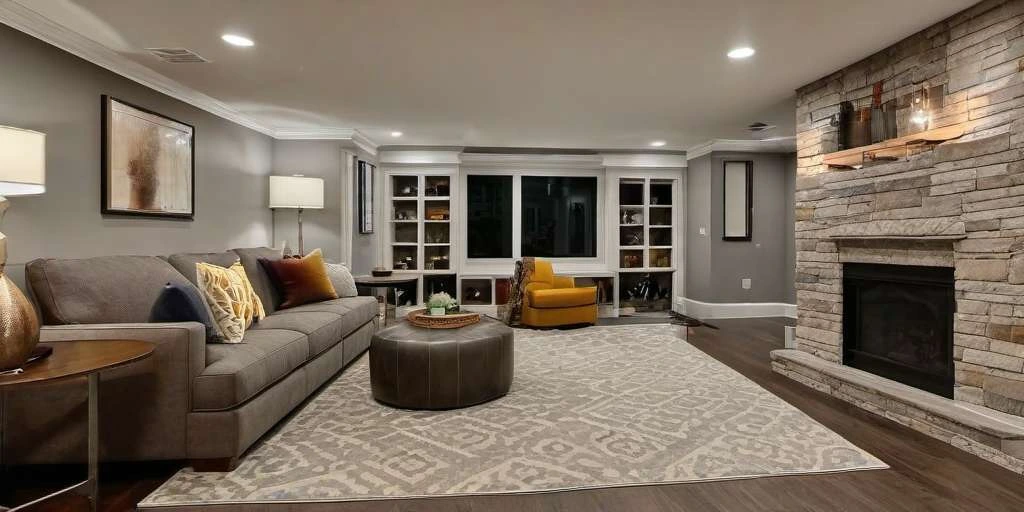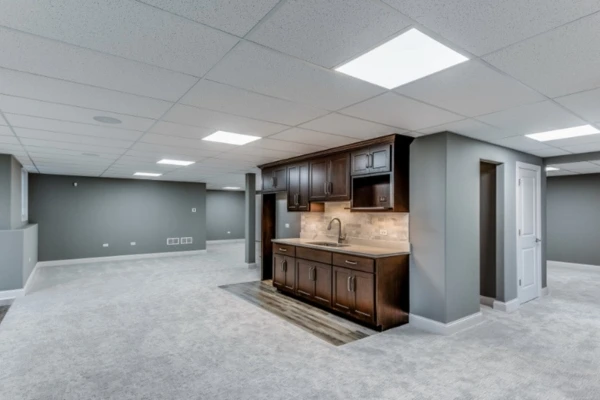How Much Does Remodeling a Basement Cost in New Jersey?
Basement Finishing can significantly enhance a home’s functionality and value. Understanding the costs involved is essential for planning a successful renovation. Factors such as size, features, and labor can influence the overall price. Incorporating elements like kitchen additions and popcorn ceiling removal should also be considered in the budgeting process.

Understanding Basement Finishing Costs
Finishing a basement involves several factors that contribute to the overall costs, including average price ranges and specific elements that influence expenses. A wide array of factors must be taken into account to estimate a realistic budget for completion.
National Average and Price Range
The national average cost to finish a basement can vary significantly based on location and project specifics. Generally, the typical range for completing a basement can fall between $7,000 to $23,000 for an area of about 1,000 square feet. This is a broad estimate, and actual costs can differ depending on various aspects such as current condition, materials, and labor.
Homeowners should also be aware that the total cost could escalate up to $100,000 if extensive renovations or additional features are included. On average, completing a basement can land around $32,000, but this figure can swing widely from as low as $2,800 to as high as $175,000, reflecting the diversity in project demands.
Factors Affecting Costs
Several key elements can significantly alter the cost cost of finishing a basement. Understanding these factors is essential for accurate budgeting.
- Condition of the Existing Space: The starting condition of the basement is a primary cost influencer. A completely unfinished basement will necessitate more extensive work compared to one that is partially finished. This includes considerations for electrical systems, plumbing, and insulation.
- Size and Square Footage: Larger basements naturally incur higher costs, with expenses typically ranging from $7 to $23 per square foot. This could lead to varying totals based on the overall area to be completed.
- Features and Amenities: Including additional rooms, such as bathrooms or kitchens, amplifies the cost. Moreover, high-end finishes and appliances will further elevate the budget, necessitating meticulous planning.
- Labor Costs: Labor represents a significant portion of the overall expenses, accounting for around 40% of the total budget. Whether hiring a contractor or opting for DIY approaches can greatly impact the final figures.
- Permits and Regulations: Obtaining the necessary permits to ensure compliance with building codes adds additional expenses. These costs can range from $1,200 to $2,000 depending on the complexity of the project.
As these costs can vary greatly from project to project, it’s crucial to analyze individual circumstances and preferences thoroughly before commencing any finishing project. By addressing these factors and strategizing effectively, homeowners can achieve a successful basement completion that aligns with their budget and lifestyle needs.
Specific Areas and Features
Understanding the costs associated with specific areas and features during basement finishing is essential for budgeting. Each section of the basement has unique requirements and expenses that can significantly impact the overall investment.
How Much to Finish a Basement Bathroom
Finishing a basement bathroom is an attractive addition, as it maximizes the utility of the space. The cost to finish a basement bathroom typically ranges from $5,000 to $15,000. Key components that influence the total cost include:
- Plumbing installation and fixtures
- Electrical work for lighting and outlets
- Finishes such as tiles and vanities
- Ventilation systems to prevent moisture buildup
Costs may increase if the bathroom requires additional features, such as a full shower or bathtub installation. Proper planning and selecting efficient materials can help manage expenses.
Cost to Finish a Basement Bedroom
Transforming part of a basement into a bedroom can provide additional living space. The costs associated with finishing a basement bedroom can vary widely, generally falling between $10,000 and $25,000. Important factors include:
- Proper egress windows or exit doors for safety
- Insulation and soundproofing for privacy
- Heating and cooling solutions tailored for the basement
- Finish materials like flooring, walls, and ceilings
When designing a bedroom, ensuring the area meets local building codes is crucial to avoid potential issues down the line.
Expense of Completing a Small Basement
The expense of finishing a smaller basement differs from larger spaces, primarily due to the reduced square footage. Generally, the cost can range from $5,000 to $15,000. Factors that play a significant role include:
- Size and layout of the basement
- Functional design, whether it’s a playroom, office, or other use
- Quality of materials selected for construction and finishing
Smaller areas often benefit from creative design choices, enabling the homeowner to maximize the space’s functionality while minimizing costs.
Adding a Kitchen or Bar
An increasingly popular choice is to create a kitchen or bar area in the basement, enhancing entertainment options and home value. The cost to add a kitchen or bar can vary significantly, often ranging from $15,000 to upwards of $30,000, depending on design choices and fixture quality. Considerations include:
- Plumbing and electrical requirements for appliances
- Countertops and cabinetry materials
- Flooring and seating arrangements
- Appliance selection, from refrigerators to ovens
Integrating a kitchen or bar adds functionality, transforming the basement into an inviting area for family gatherings or entertaining guests.
Key Cost Components
The cost of finishing a basement encompasses several key components that significantly influence the total investment required for the project. Understanding these components is essential for creating a realistic budget and effectively planning the remodel.
Electrical Work and Plumbing
Electrical work and plumbing are crucial aspects when finishing a basement. These installations ensure the space is functional and comfortable. Key considerations include:
- Bringing existing electrical systems up to code, which may involve upgrading the panel or adding dedicated circuits.
- Installing lighting fixtures, outlets, and switches wherever necessary.
- Setting up plumbing for sinks, bathrooms, or kitchens, which can vary in cost depending on the complexity of the layout.
Insulation and Drywall
Effective insulation and drywall installation play a significant role in the comfort of a finished basement. Adequate insulation helps regulate temperature and reduce energy costs. The costs for these materials and labor can vary based on several factors.
Benefits of Finished Drywall
Finished drywall not only provides a polished look to the basement but also offers numerous benefits, including:
- Enhanced insulation properties, helping to keep the basement warm in winter and cool in summer.
- Improved fire resistance, providing an extra layer of safety for the home.
- Soundproofing capabilities, minimizing noise pollution from other parts of the house.
Flooring Options and Costs
The choice of flooring greatly impacts both aesthetics and functionality. Several types of flooring materials are available, each with varying price points. Common options include:
- Carpet, which provides warmth and comfort, typically costing between $3 and $11 per square foot.
- Laminates and vinyl, offering durability and ease of maintenance, priced around $2 to $5 per square foot.
- Hardwood, known for its elegance but potentially costing up to $22 per square foot.
Ceiling Choices: Drop vs. Other Types
The choice of ceiling type can notably affect the overall look and cost of the project. A drop ceiling is popular for basements due to its accessibility and ease of installation. Key options include:
- Drop ceilings, which typically range from $2 to $6 per square foot, allowing for easy access to plumbing and electrical systems.
- Drywall ceilings, providing a sleek, clean finish but requiring more labor and installation costs.
- Acoustic ceilings, which can help reduce noise levels, particularly useful in multi-use basement spaces.
Detailed Cost Influencers
Understanding the various factors that can influence the costs associated with finishing a basement is crucial for homeowners looking to embark on such a project. Several elements, including size, condition, labor costs, and required permits, can significantly impact the overall expense.
Size and Square Footage: Full Size vs. Small
The total size of the basement plays an essential role when estimating finishing costs. Generally, the larger the area, the higher the expenses will be. Costs typically range from $7 to $23 per square foot for finishing. This means that a full-size basement will result in a more considerable investment compared to a smaller one.
Condition of the Existing Space
The starting condition of the basement is another critical determinant of costs. An unfinished basement will require more extensive work, including installation of essential systems such as plumbing, electrical wiring, and insulation.
Partially Finished Basement Considerations
If the basement is already partially finished, costs may be lower since some elements, like framing or drywall, might already be in place. Homeowners can save significantly when they only need to complete the remaining sections, which reduces the overall labor and material costs.
The Unfinished Furnace Room
Unfinished areas designated for furnaces or other utilities may require special considerations, especially concerning safety regulations and accessibility. These sections might also necessitate additional work to integrate them properly into the finished design, leading to increased costs overall.
Labor and Material Costs
Labor represents a significant portion of the expense associated with finishing a basement. The complexity of the project influences labor costs, which can vary widely based on location and the skill level of the contractors hired.
Hiring Professionals vs. DIY
Homeowners face the choice of hiring professionals or engaging in DIY work. While DIY can save on labor costs, it requires time, effort, and expertise. Mistakes made by inexperienced individuals can lead to greater expenses down the line, particularly in areas like plumbing and electrical work that must meet strict building codes.
Cost of Permits and Meeting Building Codes
Finishing a basement often involves securing the necessary permits, which can range from $1,200 to $2,000. These costs depend on the scope of the project and local regulations. Adhering to building codes is crucial for ensuring safety and minimizing future legal issues or complications during home inspections.
Value and ROI Considerations
The value of finishing a basement goes beyond immediate aesthetics and functionality. It is essential to evaluate its potential return on investment (ROI) and broader impact on the property value.
Is Finishing Your Basement Worth the Money?
Investing in a finished basement can yield significant benefits, provided the project is approached thoughtfully. Homeowners often grapple with the question of whether the costs involved justify the expenditure. A well-executed basement finishing project can transform an underutilized space into a comfortable living area, which may enhance the overall livability of the home.
While the initial outlay may appear daunting, statistics suggest that finished basements often recoup a considerable portion of their cost upon resale. Many homeowners find that they enjoy the extra space for family activities, entertainment, or home offices, contributing not only to their quality of life but also serving as a sales point during property transactions.
Impact on Your Home’s Value
A finished basement can significantly increase a home’s market value. Real estate professionals frequently note that completed basements add to the square footage of a property, which positively influences appraisals and sale prices. According to various studies, homeowners can expect to recover approximately 80% of their renovation costs when selling the home.
Moreover, a finished basement presents opportunities for showcasing additional features that appeal to buyers, such as:
- Extra bedrooms or an in-law suite
- A recreation room or home theater
- A dedicated office space
- A personal gym or yoga studio
Each of these elements not only adds functional space but also enhances the property’s attractiveness to a broader range of potential buyers, thereby potentially reducing time on the market.
Potential Rental Income Opportunities
Turning a finished basement into a rental unit is another way to leverage the investment. Many homeowners explore options such as creating separate living quarters or even short-term rental spaces through platforms like Airbnb. This setup can produce consistent rental income and address housing demands in many neighborhoods.
Key considerations when converting a basement into a rental include:
- Ensuring compliance with local laws and regulations
- Accommodating necessary utilities, such as plumbing and electricity, to support a kitchen or bathroom
- Providing adequate egress options for safety
Rental units in finished basements can enhance cash flow, making the home not only more valuable but also a source of recurring income for homeowners. This added financial benefit may justify the initial costs associated with the project.
Budgeting and Planning the Project
Effective budgeting and meticulous planning are critical for any basement finishing project. Establishing a solid financial framework helps homeowners navigate potential costs and ensures the project stays on track.
Creating a Realistic Budget
Formulating a realistic budget involves assessing all potential costs associated with finishing a basement. Homeowners should consider both direct and indirect expenses. Essential components to include are:
- Materials: This encompasses everything from drywall and insulation to flooring and fixtures.
- Labor: Estimate costs based on whether professionals will be hired or if DIY efforts will take place.
- Permits: Fees can vary by location but should be factored into the overall budget.
- Contingency funds: Setting aside 10% to 20% of the total budget for unforeseen expenses is advisable.
Detailing all line items helps ensure that homeowners will not be caught off guard during the renovation process. Break down costs based on specific areas of the project for better clarity.
Planning for Surprises and Overruns
No construction project is without surprises. To mitigate unexpected costs, be proactive in planning. Consider these strategies:
- Thorough inspections: Assessing the existing space beforehand can uncover hidden issues that might require remediation.
- Clear project scope: Defining the extent of renovations can help avoid scope creep, which can inflate costs.
- Flexible timelines: Allow for potential delays in construction, as they can affect overall costs.
Appropriate planning for surprises ensures funds are available when unexpected situations arise.
Tips for Homeowners
Having a well-thought-out plan can contribute significantly to the success of the basement finishing project. Homeowners are encouraged to follow these tips:
Consulting with Lee Sheetrock Home Remodeling
Engaging with a professional company like Lee Sheetrock Home Remodeling can provide valuable insights and assistance in budgeting. Experts can help identify realistic costs and suggest high-quality materials that fit within a required budget. Their experience can be crucial for navigating any regulatory requirements and ensuring compliance with local codes.
Including Popcorn Ceiling Removal in Your Plan
When planning the finishing of the basement, popcorn ceiling removal is also a consideration that may impact both costs and aesthetics. This task can significantly alter the feel of the space, making it feel more modern and inviting. However, it is essential to factor this into the budget as it may involve additional costs for labor and disposal. Proper preparation and consideration of this element will enhance the overall finish of the basement.



